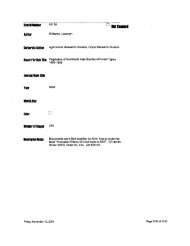Item ID Number - Special Collections
Item ID Number - Special Collections
Item ID Number - Special Collections
Create successful ePaper yourself
Turn your PDF publications into a flip-book with our unique Google optimized e-Paper software.
-11-<br />
column of sandy loam type soil. Water was then slowly dropped onto the<br />
surface of the sand at a rate of approximately 2 rnl/hr. The water and<br />
sections of soil were extracted with chloroform. Three groups of invertebrates<br />
were used for the pesticide accumulation study: Qatracoda<br />
species, Artemis, salina, and Aedes aegypti larvae, and one fish species<br />
northern brook silverside, Laludesthes sicculus sicculus. Pour pesticides<br />
were selected from representative groups of important compounds:<br />
dioxin (TCDD), DDT, /-3HC, and zectran. All compounds were l^-labeled<br />
in the benzene rings. Three model ecosystems were used to study<br />
bioaccumulation.<br />
In model I, the pesticides (5 and 10 pmole) dissolved in a solvent<br />
were added directly to water along with the primary food organism,<br />
such as algae and yeast, and this mixture was then added to the aquarium<br />
containing the invertebrate test organisms.<br />
In model II, the pesticides (20 pmole) were deposited on the inner<br />
surface of the glass container by evaporating the solvent to form a<br />
thin film. The primary food organism were grown in the container for<br />
2U hr. and then transferred along with the culture media to the aquarium<br />
contairihg the test invertebrate organism.<br />
In model III, the pesticides (5 and 10 praole) were deposited on 1<br />
g of sand and the solvent evaporated to form a thin film on the surface<br />
of the sand particles. The sand was added to the test aquarium containing<br />
invertebrates and/or fish.<br />
In all cases the test organisms were maintained in the aquarium at<br />
room temperature (2U° C), except for the fish cultures which were maintained<br />
at 12° C. Test organisms were either homogenized in counting<br />
solution or carbonized (Model 300 Packard Tri-Carb Oxidizer), and the<br />
amount of ^C02 measured. Measurements of the amount of labeled material<br />
in the water, primary food organism, and on sand and glass surfaces<br />
were made by extracting with chloroform. All studies were short-term<br />
(k-7 days), in small volume containers (200 ml).<br />
As shown in Table 8, the extent of translocation of TCDD from the<br />
sand to the organic soil layer is extremely small. Virtually no TCDD<br />
was found to leach out from the column. The mobility of TCDD in soil,<br />
therefore, must be considered much less than that of DDT. Thus, the<br />
mode of translocation of TCDD in the environment would be limited to<br />
movement of soil particles or dust-carried dispersion and biological<br />
transfer (but not plant-mediated transfer), particularly in aquatic environments.<br />
As for the microbially mediated degradation of TCDD, our current<br />
survey indicates that such capabilities are rather rare in nature. Approximately<br />
100 microbial strains in which the ability to degrade persistent<br />
pesticides has been previously demonstrated were screened for<br />
this purpose. Among them, only five strains showed some ability to de-
















